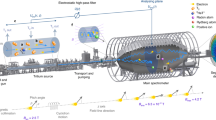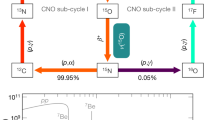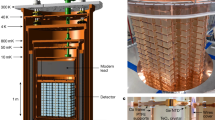Abstract
THE state of the experiment designed to detect solar neutrinos by the reaction ν+37Cl→37Ar (T1/2 = 35d)+e−(threshold = 814 keV) has been summarised by Bahcall and Davis1, who report essentially a null result for the average of many runs over the past few years. The experiment is sensitive only to a tiny fraction of the total flux, that is to neutrinos arising from the 8B decay (Table 1) and it is therefore essential to have another experiment which responds to the lower energy, more abundant neutrinos if the fundamental ideas about the mechanisms by which the Sun produces its energy are to be tested. There seem to be very few1,2 experiments with this property and an interesting alternative approach has been suggested by Freedman et al.3. They hope to obtain a value of the average flux during the past few Myr by measuring the 205Pb produced in old, thallium-rich minerals in the reaction ν+205T1→205Pb (T1/2 = 1.6×107y)+e− (threshold = 46 keV), which is sensitive to all parts of the neutrino-producing chain. The purpose of this communication is to investigate the feasibility of detecting solar neutrinos through the reaction ν+81Br→81Kr (T1/2 = 2.1 × 105 y)+e− (threshold = 490 keV), which turns out to be sensitive mostly to the 7Be neutrinos, the second most abundant in the chain.
This is a preview of subscription content, access via your institution
Access options
Subscribe to this journal
Receive 51 print issues and online access
$199.00 per year
only $3.90 per issue
Buy this article
- Purchase on Springer Link
- Instant access to full article PDF
Prices may be subject to local taxes which are calculated during checkout
Similar content being viewed by others
References
Bahcall, J. N., and Davis, R., Science, 191, 264–267 (1976).
Raghavan, R. S., Phys. Rev. Lett., 37, 259–262 (1976).
Freedman, M. S., et al., Science, 193, 1117–1119 (1976).
Goldschmidt, V. M., Geochemistry, 601 (Oxford University Press, London, 1958).
Bahcall, J. N., and Sears, R. L., A. Rev. Astron. Astrophys., 10, 25–44 (1972).
Bahcall, J. N., Phys. Rev., 135 B, 137–146 (1964).
Eugster, O., Eberhardt, P., and Geiss, J., J. geophys. Res., 74, 3874–3896 (1969).
Freyer, H. D., and Wagener, K., Z. Naturforsch., 25 A, 1427–1430 (1970).
Author information
Authors and Affiliations
Rights and permissions
About this article
Cite this article
SCOTT, R. Possibility of using 81Kr to detect solar neutrinos. Nature 264, 729–730 (1976). https://doi.org/10.1038/264729a0
Received:
Accepted:
Issue Date:
DOI: https://doi.org/10.1038/264729a0
This article is cited by
-
Geochemical integrations of the neutrino flux from stellar collapses
Nature (1988)
-
Solar neutrinos: a field in transition
Nature (1988)
Comments
By submitting a comment you agree to abide by our Terms and Community Guidelines. If you find something abusive or that does not comply with our terms or guidelines please flag it as inappropriate.



